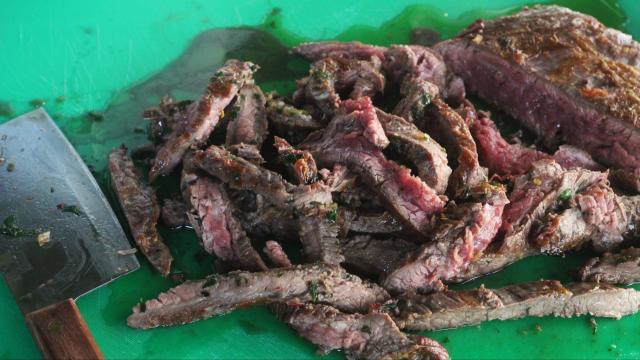I don’t usually heavily season my steaks — I like to let the meat speak for itself — but there is something deeply enticing (and summery) about a pile of flame-kissed beef that’s been dressed with a bright, aggressively herby sauce. Like most people, I used to make my sauces separately and serve them alongside the beef. Then I learned about board dressings — also known as “board sauces” — and my life improved.
A board dressing is exactly what it sounds like: It’s a dressing that’s made right on the cutting board. You take some olive oil, you take some fresh herbs, and you take some garlic. You chop up the latter two and mix them with the oil in a coffee cup. When you’re steak is done cooking (whether on the grill or in the pan), you pour the contents of the mug on a cutting board, place the — hot, unrested — steak in that delicious mess, and slice and toss it, mixing the oil with the meat’s juices to create an immensely flavorful sauce. It works really well on large-format steaks, particularly flank and skirt, but you can use it on pork, lamb, and even shrimp (which don’t need to be sliced, just tossed).
If you’ve been grilling for a while, you might have already heard of board sauces. Created (or at least popularised) by Adam Perry Lang, the board sauce has been around for over a decade. (Perry Lang has since been linked to Jeffrey Epstein, for whom he worked in the early 2000s; you can read about that here, but there are enough recipes for board sauces that you can avoid supporting Perry Lang if you want to — AmazingRibs.com has a recipe that’s quite delicious.) According to Meathead Goldwyn, “Nothing salvages an overcooked steak like a board sauce… The board sauce keeps the meat moist, and brings interesting flavours to the insides of the meat. Surprisingly, shockingly, the herbs do not overpower the meat.”
And though you can find quite a few recipes for board dressings and sauces online, you don’t really need one. Aim for a ratio of 6 tablespoons of fat and 2 tablespoons of chopped fresh stuff for 1 kg of meat. Olive oil is a great base, buy you can use rendered animal fat, or any other oil that pleases you. (I am going to make my next one with a mixture of plain vegetable oil and toasted sesame.) The “fresh stuff” is also similarly riffable; I made mine with a mixture of fresh marjoram, thyme, oregano, and parsley, along with a couple cloves of crushed garlic and a few pinches of salt, pepper, and red pepper flakes, though I did not measure each individual component.
The flank I dressed with the resulting sauce turned out fabulously; even the more well-done portions of the tapered steak felt tender and moist and tasted delicious. I think I’ll get a fresh chilli involved next time, and maybe some citrus zest and/or juice, and I’ll definitely be adding more alliums (probably spring onions). With so many potential flavour combinations. I suspect I’ll be making board sauces all spring and summer long.

Leave a Reply
You must be logged in to post a comment.